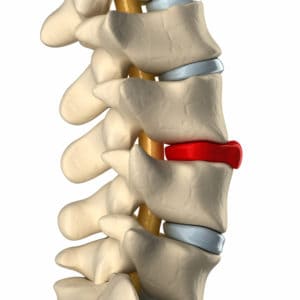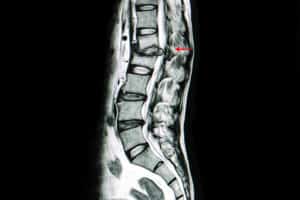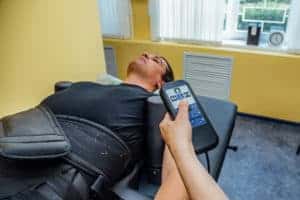Millions of people suffer from some kind of neck or back pain each year. There are many common causes of back and neck pain, and some of those causes have to do with spinal discs. The spine is made up of vertebrae stacked one on top of the other and separated by tough, spongy discs. These spinal discs help to absorb the shock from everyday movements and keep the bones of your spine from rubbing against one another. Spinal discs also allow for more movement and flexibility in the vertebrae joints that make up your spine.
When a spinal disc is aggravated, damaged, or starts to wear down, it can cause pain and other symptoms. Talk to your doctor about any back or neck pain you have been experiencing, along with any other symptoms, and find out what type of disc herniation treatment will work best for you. There are natural remedies for bulging discs that can help you avoid more invasive surgical procedures.
What Is a Bulging Disc?
 In between each vertebra in the spine is a spinal disc. These round discs are comprised of a tough outer shell with a soft, gel-like inner nucleus. Spinal discs function as shock absorbers for the spine and help hold the vertebrae of your spine together. A healthy spinal disc fits in between two vertebrae and fits into the same space in the spinal column as a vertebra does. When a spinal disc becomes damaged, irritated, or worn down, it can become what is known as a bulging disc.
In between each vertebra in the spine is a spinal disc. These round discs are comprised of a tough outer shell with a soft, gel-like inner nucleus. Spinal discs function as shock absorbers for the spine and help hold the vertebrae of your spine together. A healthy spinal disc fits in between two vertebrae and fits into the same space in the spinal column as a vertebra does. When a spinal disc becomes damaged, irritated, or worn down, it can become what is known as a bulging disc.
A bulging disc is when a spinal disc has a flattened or deflated look, and its tough outer shell is bulging slightly outside of the space it would normally take up. Think of a bulging disc like a jelly donut: it has an outer shell with an inner jelly-like substance. If you flatten the donut but don’t break the outer shell, then the donut may look deflated and become a slightly larger shape. This is what happens with a bulging disc: some part or all of the spinal disc flattens out and the disc bulges outside its normal circumference. When this happens, the protruding or bulging part of the disc can put pressure on nearby nerves and disrupt the healthy functioning of the spine. A bulging disc can also mean less shock absorption for the spine.
Symptoms of a Bulging Disc
The most common symptom of a bulging disc is neck or back pain and pain in the extremities. When the bulging disc aggravates a nearby nerve, it can cause pain, tingling, and numbness to extend into areas of the body that the particular nerve controls. For example, a bulging disc in your neck may cause pain in your neck, along with pain in your shoulder, arm, and into your fingers. Similarly, a bulging disc in your lower back may cause lower back pain, along with pain in your hip, buttocks, leg, and foot. When the bulging disc puts pressure on nerves in the spinal canal, it can interfere with the healthy functioning of your central nervous system. This is why, in addition to pain, you might also experience tingling, weakness, and numbness, which are common signs and symptoms of an aggravated or damaged nerve.
Common Causes of a Bulging Disc
Once you know your pain is caused by a bulging disc, you might wonder how this happened. Here are common causes of a bulging disc in the neck and back.
Osteoarthritis
Osteoarthritis in the spine is one of the most common reasons for a bulging disc. The lower back is the most common part of the spine affected by osteoarthritis. Arthritis causes inflammation and degeneration in your lower back, which can cause pain, stiffness, and swelling in the area. Damaged spinal discs are not able to absorb stress and strain on the spine as effectively, which can actually aggravate other osteoarthritis symptoms, turning this into a cycle of pain and discomfort.
Wear & Tear
Wear and tear on the body as you age can also lead to a bulging disc. General wear and tear over time will cause the spinal discs to lose some of their elasticity over time. As the gel-like insides of the spinal disc start to dry out, it can make the spinal disc more susceptible to damage and degeneration. The spine is put under a lot of pressure and stress each day, and eventually, that will have an impact on the health and stability of the spinal discs that support your spine. Disc degeneration can cause a bulging disc, which refers to wear and tear on the spinal discs as you age.
Acute Injury
A sudden or acute injury to the spine can also cause a ruptured disc. Car accident injuries or sports injuries can aggravate or injure parts of the spine, causing a disc to lose its shape and bulge outward. An accidental injury like a slip and fall can also disrupt the spine, and that amount of shock and stress to the spine can cause affected spinal discs to wear down quicker than they might with normal wear and tear on the body.
Poor Posture
If you are constantly sitting, standing, and even sleeping with poor posture habits, then you are more susceptible to developing a bulging disc. When your spine doesn’t get the proper support it needs from proper alignment, it can end up putting too much pressure on certain parts of the spine. For example, sitting slouched or hunched forward for long periods of time can put a lot of stress and strain on your neck, which puts more wear and tear on the spinal discs that support the spine in your neck.
Diagnosing a Bulging Disc
 In order to diagnose a bulging disc, your doctor will want to talk to you about your symptoms, your medical history, and any recent falls or injuries you may have suffered. They will also want to perform a physical examination of where you are experiencing pain and other symptoms. A doctor may also want to run diagnostic imaging tests of the affected area to get a better look at what is going on with your spine. An X-ray will show black and white images of bones and cartilage in your body, which can also help rule out any fractures or broken bones. A CT scan or MRI will show soft tissues like spinal discs in addition to bones, which provide a more detailed look at how you may have a bulging disc in part of the spine.
In order to diagnose a bulging disc, your doctor will want to talk to you about your symptoms, your medical history, and any recent falls or injuries you may have suffered. They will also want to perform a physical examination of where you are experiencing pain and other symptoms. A doctor may also want to run diagnostic imaging tests of the affected area to get a better look at what is going on with your spine. An X-ray will show black and white images of bones and cartilage in your body, which can also help rule out any fractures or broken bones. A CT scan or MRI will show soft tissues like spinal discs in addition to bones, which provide a more detailed look at how you may have a bulging disc in part of the spine.
Bulging Disc vs. Herniated Disc
It is important to point out the difference between a bulging disc and a herniated disc, both of which can cause similar types of pain and symptoms. The primary difference between a bulging disc and a herniated disc is that with a disc herniation, the outer shell of the disc actually cracks or tears and allows part of that gel-like center to escape. The inside of a disc slipping out of its shell is what puts pressure on nearby nerves and causes pain, tingling, and other uncomfortable symptoms. When you visit your doctor for back pain, they may want to use diagnostic imaging tests like a CT scan or MRI to get a better look at the discs in your spine and determine whether your pain is caused by a bulging disc or a herniated disc. It is possible for a bulging disc to develop into a herniated disc, so your doctor will want to monitor your bulging disc while you undergo treatment to ensure you are healing properly.
Natural Treatment Options for a Bulging Disc
 Many treatment options are available for treating a bulging disc and managing your symptoms while you heal. When you visit a doctor for a bulging disc, they will likely discuss more conservative treatment options to try first, including healing a bulging disc naturally. Here are some examples of how to heal a bulging disc naturally so you can experience lasting pain relief without worrying about having to undergo invasive procedures:
Many treatment options are available for treating a bulging disc and managing your symptoms while you heal. When you visit a doctor for a bulging disc, they will likely discuss more conservative treatment options to try first, including healing a bulging disc naturally. Here are some examples of how to heal a bulging disc naturally so you can experience lasting pain relief without worrying about having to undergo invasive procedures:
At-Home Remedies
When a bulging disc is causing you mild pain and discomfort, your doctor may recommend at-home remedies to help manage your symptoms while you heal. This could include a recommendation of taking over-the-counter pain relievers if you are recovering from a recent injury that may have caused the bulging disc. If you were recently injured in a car accident or while playing sports, your doctor might recommend that you rest for a few days, which can also help reduce any swelling and inflammation. Applying cold compresses to painful areas with inflammation can also provide natural pain relief while reducing swelling naturally. Your doctor may also recommend these at-home remedies alongside an in-office bulging disc remedy like chiropractic care or physical therapy.
Chiropractic Care
Chiropractic care is an all-natural treatment option to address a wide range of musculoskeletal conditions and injuries, including a bulging disc. Atlanta chiropractors do not prescribe medications and instead focus on the body’s natural healing abilities and restoring healthy functioning to the body naturally. When you visit a chiropractor for a bulging disc, they will use all-natural techniques like manual spinal adjustments and therapeutic massage to help restore healthy alignment in your spine. The evidence-based practice of chiropractic care and chiropractic adjustments can help restore proper alignment of vertebrae and spinal discs, which will also reduce pressure on nearby nerves.
Physical Therapy
Physical therapy also provides natural remedies for bulging discs through therapeutic stretches and exercises. A physical therapist will work with you to manage your pain and other symptoms while also alleviating pressure, stress, and strain on the spine. Physical therapy stretches and exercises help you regain strength in muscles that support your spine so you can practice better posture throughout your day and be able to better distribute your weight and everyday movements on your spine. Doctors recommend physical therapy for low back pain treatment to help you effectively recover and prevent future stress and strain on the back.
Stretches to Try for a Bulging Disc
Consider these low-impact stretches to try that can help relieve the pain and discomfort of a bulging disc.
Cobra Pose
Cobra pose is commonly known among yoga enthusiasts, but you don’t have to attend a yoga class to try this stretch. Start by lying on your stomach with your legs together comfortably, your arms bent and palms beneath your shoulders. Then gently press your upper body up and extend your chin up toward the ceiling. The cobra pose will help stretch and elongate your spine, which can help take pressure off of spinal discs and help to redistribute pressure on your spine.
Cat-Cow Pose
Cat-cow pose is another yoga stretch that can help alleviate your pain and discomfort from a bulging disc. Start on your hands and knees with your hands directly below your shoulders and your knees directly below your hips. As you take a deep breath, arch your back and relax your stomach toward the floor while you look up toward the ceiling. Then exhale and gently round your spine, arching your back in the opposite direction, and drop your chin to your chest.
Knee Hugs
Knee hugs are a low-impact way to stretch out your spine and take the pressure off of a bulging disc. Lie on your back with your legs extended and both heels on the ground. Slowly bring one knee up to your chest and place your hands gently on the knee, like you are hugging your bent knee. Then replace that leg to the ground and pull the opposite knee to your chest.
Non-Surgical Treatment for a Bulging Disc
If you are looking for natural and non-surgical treatment options for a bulging disc, then visit our team of spine doctors at AICA Orthopedics for quality and comprehensive care. Our team of doctors includes orthopedic doctors, chiropractors, and physical therapists, all in one convenient location with multiple clinics across metro Atlanta, so you can find a location near you. Don’t let neck or back pain affect your quality of life and keep you from participating in the activities you enjoy. Get started healing a bulging disc naturally with our team of doctors at AICA Orthopedics today!
Sources
- Zou, J., Yang, H., Miyazaki, M., Morishita, Y., Wei, F., McGovern, S., & Wang, J. C. (2009). Dynamic bulging of intervertebral discs in the degenerative lumbar spine. Spine, 34(23), 2545–2550. https://doi.org/10.1097/BRS.0b013e3181b32998
- Lefebvre, R., Peterson, D., & Haas, M. (2012). Evidence-Based Practice and Chiropractic Care. Journal of evidence-based complementary & alternative medicine, 18(1), 75–79. https://doi.org/10.1177/2156587212458435
- Shipton E. A. (2018). Physical Therapy Approaches in the Treatment of Low Back Pain. Pain and therapy, 7(2), 127–137. https://doi.org/10.1007/s40122-018-0105-x